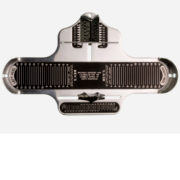What is a hammertoe and solutions to relieve the pain
Hammertoes are a biomechanical condition caused by imbalance of the muscles, tendons, and/or ligaments which hold the toe in a straight position. Foot structure, types of shoegear, genetics, trauma, and certain disease processes such as arthritis and diabetes can lead to this deformity. Women are much more likely to develop the deformity in comparison to men. Hammertoes
are mostly seen in the second, third, and fourth toes of the foot. In basic terms, it is a condition of curling of the toe and its downward rotation which results in a claw/hammer type look. The deformity is mostly seen in the middle joint of the toes. In early stages, hammertoes are flexible and can be corrected and remain pain free with conservative solutions and without surgical assistance, however, if left untreated they can become quite painful to live with and can also be quite unsightly.
Over time the hammertoes become more pronounced due to prolonged pressures of narrow shoes and high heels. The hammertoe can also be caused by bunion development along the outside of the big toe. As more pain develops, hammertoes are unable to correct themselves out and in severe conditions can start crossing over the adjacent digits. The pain from malpositioned toes is usually felt in the first joint of the affected toes – the proximal interphalangeal joint – the pointed joint continues to throb with prolonged use of shoes with narrow toe boxes, thus limiting activity level due to intense pain and discomfort.
Fortunately, there are solutions to prevent this from happening, so follow our three easy steps to keep your feet healthy and pain-free.
Change Up Your Footwear
You would be surprised by how much the simple change of shoes can help prevent the condition from progressing. According to the American Academy of Orthopedic Surgeons, a toe box that is too narrow or too short in shoes will cause the toes to compress and curl under to make room for the rest of the foot. A pair of shoes with deep toe boxes of a minimum of a half-inch of space between the longest toe and at the end of the should be worn. Medical grade or custom inserts for daily use are also highly recommended as they correct the biomechanical imbalances of the foot and balance all tendons to prevent progression and worsening of the hammertoes.
Exercises and Stretching
Keeping the toe joints flexible is one of the most common recommendations passed on from your podiatrist. Stretching and strengthening the toes can be done with simple activities at home, such as picking up marbles with the affected toes, using a towel to gently stretch the curved joints and rolling the toes on a golf ball or a water bottle.
Reducing Inflammation
The hammertoe is constantly under stress, so reducing inflammation is standard for patients dealing with discomfort. You may feel immediate relief from non-prescription pain relievers such as aspirin and ibuprofen. Alongside the medication, icing the affected toes 10 minutes at a time can effectively reduce inflammation and relieve pain quickly.
Dealing with hammertoes and foot pain varies among patients and some may need advanced physical therapy or surgical treatment. If you are struggling to manage hammertoe pain, then these conservative methods may be effective. If hammertoe pain continues to limit your everyday activities then make an appointment for surgical correction at our office, Carrollton Foot Center.






